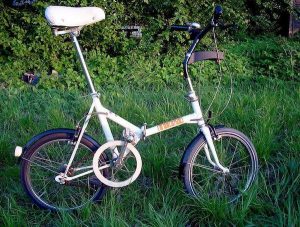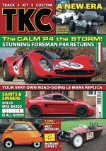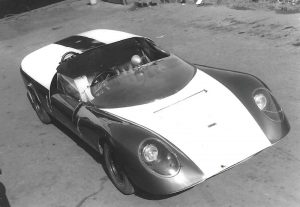THE STORY OF THE LANDAR R6 AND E.A. RADNALL COMPANY
STEVE HOLE tells the story of the little-known sixties LANDER R6 kitcar and the company behind it.
The Lander R6 was a little-known, yet pretty cool sixties kitcar built by a company with a real racing car history that could trace its origins back to the late nineteenth century.
Founded by an enterprising chap called Ernest Randall in Dartmouth Street, Birmingham in 1895, the operation was officially known as E. A Radnall Company.
Back then cycling was becoming a very popular pastime in the UK and old Ernest had been a handy Penny Farthing racer. He started to produce a range of accessories that appealed to enthusiasts.
In 1906, he added motorbikes to his inventory with the Radco, complete with his own 247cc engine. The Radco was nicknamed the ‘King of the Lightweight’.
By 1910 he was producing motorcycles, bicycles and accessories for pedal and powered enthusiasts and also leading British motorbike manufacturers such as Norton, Matchless, AJS, Royal Enfield and Triumph who all used his parts.
Radco motorcycle capacities increased up to a 610cc model in the mid-thirties although Ernest’s success ended in failure as the very companies, he was making components for ganged up and complained about him producing his own bikes, forcing him to cease production. He then reverted to concentrating on his bicycles.
Ernest’s grandsons Peter and Clive came on board when they left school and revitalised the company. They were motorsport enthusiasts and set up a separate division of the business under the Landar Components name. Ernest’s son, Ted was by then running the company.
Anyone looking for a special meaning of the name ‘Landar’ just need look no further than to spell Radnall backwards and drop one ‘L’.
Landar became well-respected in the UK motorsport scene and began building their own racing cars starting with a ‘special’ with a 500cc BSA Gold Star engine, which had been given to Peter.
In his debut race at Mallory Park in May 1959, 23-year-old Peter finished second.
The company didn’t launch their own Landar models until 1962 officially, with the R1, the first to feature Mini subframes and a rear-mounted engine with a tubular spaceframe. They tuned their own A-series engines and Clive Radnall was a dab hand on their Heenan & Freude dyno.
The R6 was their first model available in kit form although it was very much still race orientated. It was launched in January 1965 at the Racing Car Show, where several orders were taken.
The prototype R6 body was built by Wakefield & Sons next door to Brooklands in Surrey. However, the production bodies were entrusted to Williams & Pritchard. They had a GRP division back then.
It certainly gave the hordes of Lotus Elevens, Diva GTs and Elvas a run for their money, especially in the Guards Sports Racing Championship.
For those who wanted one, there was the option of a Broadspeed-tuned Cooper S package. Some notable drivers of the day drove for the Radnalls. Pedallers of the calibre of Mini racer John Handley (ETCC champion of 1968) and John Fitzpatrick, a big name in WEC were to be found driving regularly for the Radnalls.
They got on well with Broadspeed and fabricated a variety of components for Ralph Broad, although they later poached his works foreman, Mike Kenny.
Lander R6s also did well in the Canadian Sports car championship with Roger Peart while John Hill was successful in the USA in the SCCA championship.
Landar can also claim the honour of building the UK’s first Formula Vee car, in 1965, taking the fight to Austro and Autodynamic, European marques that dominated that championship.
Officially designated the R5 it had been instigated by UK VW importer Maurice Cleaver and was also known as the Smithfield. Nothing to do with the famous London meat market rather than the name of the VW works team in Formula Vee, the Smithfield Garage.
By the mid-sixties, Clive and Peter had taken over the whole Radnall operation from their father Ted renaming the company E.A.Radnall & Landar Components.
The R7 succeeded the R6 and was regarded as an improvement on its predecessor. Peter’s admiration for Bruce McLaren’s cars showed in the R7. No subframes on show here rather a tubular spaceframe. Four R7s were made.
After the R7, Landar was inundated with an increase in orders for their bicycle range and they were at the forefront of the BMX scene in the UK and beyond while Peter also designed the first folding bicycle in the UK called the Micro Bike Indeed the company had set up Micro-Cycles Ltd in 1976 to build and sell it. Peter won a Design Council award in 1978 for the product, in fact.

The Peter Radnall-designed Micro_Bike won a Design Council award in 1978. Image from the excellent The Micro bike Facebook page
They returned to car making in 1971, however, with the Frank Aston-funded R8 produced until 1983 when it was bought by a German company. The R8 was regarded as a very sophisticated model for its day.
A very well-regarded company that was really known for making parts for other people but whose cars were also really very good.
| Print article | This entry was posted by admin on October 5, 2023 at 3:12 pm, and is filed under Uncategorized. Follow any responses to this post through RSS 2.0. Both comments and pings are currently closed. |
Comments are closed.
















